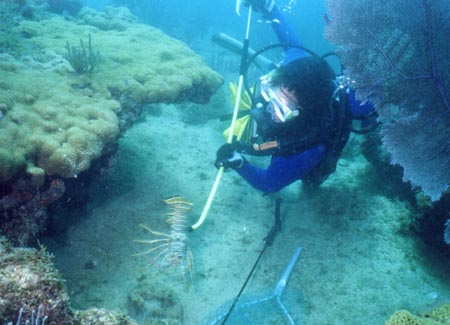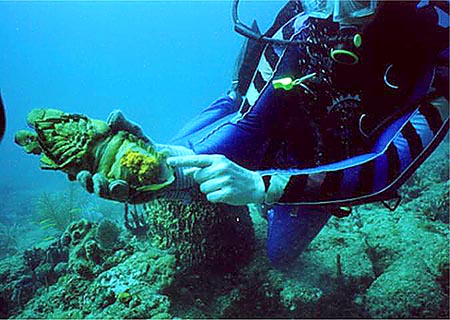![]() South Florida Divers, Inc.
South Florida Divers, Inc. ![]()

~Julie Taylor Photography |

LOBSTERS Our Favorite Crustaceans! |

|

CONTENTS:
First things first: Get Licensed
It’s the law!
Recipe: Lobster Flambé
Learning from the experts
Now we’re cooking!
Lobster recipes on the Web
Book review: My Favorite Crustacean
Mini-season Packing List
Mini-Season Report 2001: Crustaceans and Cetaceans!
|
First things first: Get Licensed ~ Julie Taylor photography  Don’t even THINK about touching a tail until you’ve obtained your Florida
Saltwater Fishing license and Lobster Permit. The fishing license
is $17.00 and the lobster permit $5; these are available at many bait
and tackle shops, dive shops, and sporting goods stores. These fees may change.
If you are a Florida resident age 65 or older possessing proof of age and
residency you don't need a license or Lobster Permit.
Don’t even THINK about touching a tail until you’ve obtained your Florida
Saltwater Fishing license and Lobster Permit. The fishing license
is $17.00 and the lobster permit $5; these are available at many bait
and tackle shops, dive shops, and sporting goods stores. These fees may change.
If you are a Florida resident age 65 or older possessing proof of age and
residency you don't need a license or Lobster Permit.
Procrastinators may have a difficult time finding an agent with permits on hand in the last days before mini season! If you wait until the last minute, not to worry...you can order an “Instant Fishing License” which allows you to fish or lobster immediately. Follow this link to buy your license online. (A $2.25 + 2.5% surcharge of total sale per person will be added to your purchase.) If you are REALLY a procrastinator...you are about to do the giant stride with tickle stick in hand when you realize you are unlicensed...grab your cell phone and dial toll-free, 1-888-FISH-FLORIDA (347-4356) from anywhere in the United States or Canada. (A $3.25 + 2.5% surcharge of total sale per person will be added to your purchase.) Have your credit card, driver’s license and Social Security number handy. With either method, you'll have a temporary license number within minutes, enabling you to hunt (in season) or fish right away. Your permanent license will be mailed within 48 hours. It’s the law!
~ Sandra Soler
photography
 The spiny lobster sport season, popularly known as "Lobster Mini-Season",
falls on the last Wednesday and Thursday of July. Bag limits: 6
per person per day for Monroe County and Biscayne National Park, and 12 per
person per day for the rest of Florida. The possession
limit on the water is equal to the daily bag limit, and off the water is
equal to the daily bag limit on the first day, and double the daily bag
limit on the second day. Possession limits are enforced on and off
the water.
The spiny lobster sport season, popularly known as "Lobster Mini-Season",
falls on the last Wednesday and Thursday of July. Bag limits: 6
per person per day for Monroe County and Biscayne National Park, and 12 per
person per day for the rest of Florida. The possession
limit on the water is equal to the daily bag limit, and off the water is
equal to the daily bag limit on the first day, and double the daily bag
limit on the second day. Possession limits are enforced on and off
the water.
Islamorada, Mile Marker 90.9-72.6 in the Florida Keys, also has some new mini-season rules. During mini-season, there is NO diving or snorkeling within:
The Commission also approved a rule amendment to reduce the recreational bag limit during the special two-day sport season in Biscayne National Park from 12 to 6 lobsters per person per day, at the request of park administration. Spiny lobster has a minimum size limit that must be larger than 3" carapace, measured in the water. A reminder that possession and use of a measuring device is required at all times, and night diving is prohibited in Monroe County (only during the sport season). A recreational saltwater license and a lobster permit is needed for harvest. Holders of a Special Recreational Crawfish License (RL) may not harvest pursuant to this license during the sport season. In addition, Commissioners approved new rule language to prohibit harvest of spiny lobsters from illegal artificial habitat. That action is aimed at reducing the use of illegal structures, sometimes called “casitas,” to harvest lobsters, especially in the lower Florida Keys. Casitas, such as dumpsters, concrete slabs, bathtubs and various other materials, are illegally placed on the seabed to attract lobsters. The secretive nature of their placement makes preventing their use difficult, and they are capable of attracting hundreds of lobsters that can be easily harvested by divers. Prohibitions: Harvest of lobster is prohibited in John Pennekamp Coral Reef State Park during the sport season. Harvest is also prohibited during both the 2-day sport season and regular season in Everglades National Park, Dry Tortugas National Park, and no-take areas in the Florida Keys National Marine Sanctuary. Regular spiny lobster season is August 6 through March 31. The bag limit is 6 per person per day. The vessel limit applies only in state waters and does not apply in federal waters. Only individual bag limits apply in federal waters. Holders of a Special Recreational Crawfish License (RL) may not harvest pursuant to this license in federal waters. The RL is only applicable in state waters. State waters extend to nine nautical miles on the Gulf of Mexico and three nautical miles on the Atlantic. Visit the Florida Fish and Wildlife Commission's Lobster Rules & Regulations page for spiny lobster laws, or their Florida Keys Lobster Regulations brochure. Kitto’s
Kitchen
4 live lobsters, (about 1 lb.
Each)
Remove and discard carapace, with strong kitchen shears cut tail along center of back, turn over and cut along center of underside. Remove meat in one piece, cut transversely to produce medallions. Peel and chop garlic leaving it rather coarse. Melt butter. Sauté garlic until it begins to brown. Add lobster medallions. Cook over high heat to keep lobster from becoming tough. Cook a few minutes. Do not overcook. Add brandy and set alight, as soon as flame extinguishes serve onto a warmed plate, drizzle with garlic butter, and garnish with fresh parsley and lemon wedges.
~ By Debby
Bradford
~ Julie Taylor photography  I’ve learned a lot from my buddies over the years. Here are a few
random thoughts from people you probably know. Joe Smariga taught me that
the slower you work at catching your intended bug, the faster you’ll catch
it. Rick Auchter taught me that icing the lobsters numbs them to
their eventual death; Jose Guaty taught me that Budweiser does the same
thing. Jose also told me to pull the swimmerets off before barbecuing.
I’ve learned a lot from my buddies over the years. Here are a few
random thoughts from people you probably know. Joe Smariga taught me that
the slower you work at catching your intended bug, the faster you’ll catch
it. Rick Auchter taught me that icing the lobsters numbs them to
their eventual death; Jose Guaty taught me that Budweiser does the same
thing. Jose also told me to pull the swimmerets off before barbecuing.
~ By Debby
Bradford
~ Julie Taylor photography  Many club members have special ways of preparing Panulirus argus.
Joe Smariga marinates them in Italian dressing before barbecuing. Bob Booth,
creator of “Bob’s Barbecued Bugs,” melts butter, honey, and fresh
minced garlic together and marinates the bugs in that before barbecuing.
The leftover marinade is a wonderful dipping sauce. Elizabeth Cohen suggested
searching foodtv.com.
A visit turned up dozens of promising ideas, including Asian recipes and
even lobster pierogies! See the next topic for more lobster recipe web
sources.
Many club members have special ways of preparing Panulirus argus.
Joe Smariga marinates them in Italian dressing before barbecuing. Bob Booth,
creator of “Bob’s Barbecued Bugs,” melts butter, honey, and fresh
minced garlic together and marinates the bugs in that before barbecuing.
The leftover marinade is a wonderful dipping sauce. Elizabeth Cohen suggested
searching foodtv.com.
A visit turned up dozens of promising ideas, including Asian recipes and
even lobster pierogies! See the next topic for more lobster recipe web
sources.
No matter how you prepare your catch, remember this: don’t overcook it! Believe it or not, there is the occasional “leftover” tail. I’ve chopped leftover cooked meat and used my standard Tuna salad recipe, earning rave reviews from co-workers. Another time I put chunks of cooked meat in red spaghetti sauce for the most delicious pasta dinner of a lifetime. I wish you safe and productive hunting...please send me your stories and photos for the August issue of The Wet Zone. Surf this turf
~ By Debby
Bradford
|
||
|
||
|
Mini-Season
Report 2001
~ By Julie
Taylor
 The waters
were rough, 2-5 feet, and the visibility was poor, 15+ feet, but we were
tough…we were resilient…we wanted LOBSTER!!! And we got them…four
divers caught 26 lobster the first day , and seven divers caught 41 the
second day. Not the limit…but a respectable catch. The nice thing was,
we really had some very enjoyable dives. A baby sea turtle sleeping in
a ledge, eels, huge puffer fish, a school of copper sweepers, really great
ledges, and just fun, relaxing, enjoyable dives. Lots of females with eggs...and
then...on our last dive...Jim Reynolds and I saw a pod of dolphin…yes,
“Flipper,” 12 or 15 of them…underwater and only 8 ft away…SOOOOO cool...they
didn’t play with us….but seeing them underwater was SOOOOO awesome!!! I
think those “dolphin experience snorkel dives” are nothing…compared to
the REAL THING!!!!.
The waters
were rough, 2-5 feet, and the visibility was poor, 15+ feet, but we were
tough…we were resilient…we wanted LOBSTER!!! And we got them…four
divers caught 26 lobster the first day , and seven divers caught 41 the
second day. Not the limit…but a respectable catch. The nice thing was,
we really had some very enjoyable dives. A baby sea turtle sleeping in
a ledge, eels, huge puffer fish, a school of copper sweepers, really great
ledges, and just fun, relaxing, enjoyable dives. Lots of females with eggs...and
then...on our last dive...Jim Reynolds and I saw a pod of dolphin…yes,
“Flipper,” 12 or 15 of them…underwater and only 8 ft away…SOOOOO cool...they
didn’t play with us….but seeing them underwater was SOOOOO awesome!!! I
think those “dolphin experience snorkel dives” are nothing…compared to
the REAL THING!!!!. |
 1
large serving spoon of brandy
1
large serving spoon of brandy
 I forget who taught me to wear a mask light for looking into their dens
hands-free, but it’s great. Steve d’Oliveira taught me to make sure
the bottom of my catch bag was secure; Jon Black taught me to make sure
the clasp at the top was secure. Jon also taught me how to freeze
cleaned tails in water-filled zip lock bags or small containers so they
would stay fresh for months. I figured out on my own how the lobsters
peer out of their dens after a “too fast” hunter has passed them by.
I forget who taught me to wear a mask light for looking into their dens
hands-free, but it’s great. Steve d’Oliveira taught me to make sure
the bottom of my catch bag was secure; Jon Black taught me to make sure
the clasp at the top was secure. Jon also taught me how to freeze
cleaned tails in water-filled zip lock bags or small containers so they
would stay fresh for months. I figured out on my own how the lobsters
peer out of their dens after a “too fast” hunter has passed them by.
 Bryan Brooks taught me why you never put them in your catch bag head first.
Bob Booth always said “lobsters are the only prey that come with their
own cleaning tool.” A forgotten dive buddy showed me that female
lobsters have double “swimmerets” while males have single ones; another
showed me how to sever the head with my knife before wringing the tail.
Matt Stout put lead shot in the head of my big dive light to keep it horizontal.
Bryan Brooks taught me why you never put them in your catch bag head first.
Bob Booth always said “lobsters are the only prey that come with their
own cleaning tool.” A forgotten dive buddy showed me that female
lobsters have double “swimmerets” while males have single ones; another
showed me how to sever the head with my knife before wringing the tail.
Matt Stout put lead shot in the head of my big dive light to keep it horizontal.
 Donna Harland taught all of us how to measure our bugs and make sure the
boat count was accurate, and to never, EVER, bag a female with eggs.
Finally, the lobsters themselves showed me how plentiful and plump they
are when they are NOT in season!
Donna Harland taught all of us how to measure our bugs and make sure the
boat count was accurate, and to never, EVER, bag a female with eggs.
Finally, the lobsters themselves showed me how plentiful and plump they
are when they are NOT in season!

